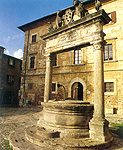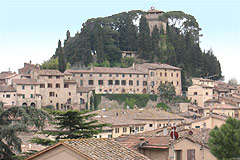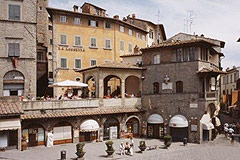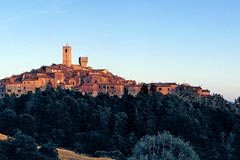In Val di Chiana...
 MONTEPULCIANO
MONTEPULCIANO
Montepulciano is built along a narrow limestone ridge and at 605 m (1,950 ft) above sea level, is one of the highest of Tuscany’s hilltop towns. The town is encircled by walls and fortifications designed by Antonio da Sangallo the Elder in 1511 for Cosimo I. This splendid little town – whose artistic and architectural heritage led it to be called the “Pearl of the Renaissance” – has preserved its beauty intact. Going up the steep streets of its outlying districts the visitor discovers beautiful palazzos and churches imbued with the unparalleled art of foremost Renaissance architects.
The splendid Piazza Grande must be seen: the Duomo with its uncompleted façade and the Town Hall, surrounded by Renaissance palazzos. The valley below is an unforgettable view with the outstanding and elegant mass of the Tempio di San Biagio.
Along the Corso, a long winding street climbing up into the main square, is the Art Deco Caffè Poliziano, which has an art gallery in the basement. In July the café hosts a jazz festival and the town fills with musicians who perform at the Cantiere Internazionale d’Arte, an arts festival directed by the German composer Hans Werner Henze. In August there are two festivals: the Bruscello takes place on the 14th, 15th and 16th, when scenes from the town’s turbulent history are re-enacted. Fro the Bravio delle Botti, on the last Sunday in August, there is a parade throught the streets followed by a barrel race and a banquet.
 CETONA
CETONA
Situated on the slopes of the mountain of the same name, Cetona retains the characteristic structure of mediaeval settlements with alleys and little roads that wind spirally on their way to the Fortress.
The prehistoric settlement of Belverde, 40,000 years old, is worth a visit. The Monte Cetona Civic Prehistory Museum is interesting with its finds from the Palaeolithic to the Bronze Age.
TOP
 CHIANCIANO TERME
CHIANCIANO TERME
With its spa centres specialised in treating liver and kidney ailments, in inhalation therapy and in functional reactivation and re-education, Chianciano Terme is one of the most important spa centres in Italy. And its fame in the field of spa cures has continued without interruption for more than 2,000 years.
This is borne out by the many Etruscan and Roman archaeological finds that are continually being discovered throughout the territory and are collected in the recently opened Civic Archaeological Museum. The tourist can also visit the historic centre: in its evocative alleys which open into picturesque piazzas there are authentic art treasures such as the Chiesa di San Giovanni, with the Collegiate Museum and the Chiesa della Compagnia (1517); just outside the Porta al Sole, the small but special Chiesa della Madonna della Rosa (1585) was built according to the design of Baldassarre Lanci.
TOP
 CHIUSI
CHIUSI
Highly important in the Etruscan period, Chiusi experienced its greatest splendour under the legendary King Porsenna. Very significant finds from archaeological digs that are still successfully under way may be seen at the National Etruscan Archaeological Museum. Opposite this museum, is the Duomo (Cathedral), which already existed in the 12th century and was transformed in 1585, and next to it is the Cathedral Museum, established in the 1930’s, which houses important objects including valuable ornately decorated missals.
Numerous Etruscan tombs have come to light on the territory: Pellegrina, Scimmia, Leone, Pania and a great many others. Christianity spread very swiftly in these places, as borne out by the Catacombs of Santa Mustiola and Santa Caterina. Besides the catacombs you can also see the so-called Labyrinth of Porsenna, an intricate network of underground passages leading to a cistern dating to the 1st century AD.
An important natural attraction is the lake of Chiusi, which offers the possibility of sport fishing and birdwatching.
TOP
 CORTONA
CORTONA
Cortona is one of the oldest cities in Tuscany. It was founded by the Etruscans, whose work can still be seen in the foundations of the town’s massive stone walls. The city was a major seat of power during the medieval period, able to hold its own against larger towns like Siena and Arezzo; its decline followed defeat by Naples in 1409, after which it was sold to Florence and lost its autonomy. The main street, Via Nazionale, is remarkably flat in comparison with the rest of Cortona. The numerous ladder-like alleys leading off it, for instance the Vicolo del Precipizio (Precipice Alley), are far more typical.
TOP
 SAN CASCIANO DEI BAGNI
SAN CASCIANO DEI BAGNI
This small centre in the far south of the province of Siena, on the boundary with Umbria and Latium, was already well known in the Middle Ages and today’s visitor sees it precisely as a typical mediaeval village, dominated by the massive rectangular turret of Palazzo Bologna.
The historic centre is worth a visit with its characteristic hill-town plan of alleys and small piazzas. Away from the centre, near the Spa, the Chiesa Basilicale, which dates to the year 1000 is of great interest. But though San Casciano, immersed in a lush and uncontaminated nature, is a favourite with farm holiday visitors, it should not be forgotten that a great many tourists come for spa cures such as inhalations, baths and mud treatments. Just a few kilometres away there is the small outlying district of Celle sul Rigo, with its majestic 13th century tower and an unforgettable view.
TOP
SARTEANO
The square Castle keep (10th century) speaks clearly of the mediaeval origins of Sarteano, which stretches along a ridge dominating the Val di Chiana.
Sarteano too can boast civil and religious buildings of indubitable interest: you are particularly urged to visit the Chiesa di San Martino in Foro. The Collegiate Church, dedicated to Saints Lorenzo and Apollinare, also contains significant works. Civil buildings worth seeing include the Town Hall, Palazzo Piccolomini, Palazzo Goti-Fanelli and Palazzo Cennini. The Teatro degli Arrischianti (Risk-Takers’ Theatre) is a gem.
The Civic Archaeological Museum, which houses important Etruscan and Roman finds, is certainly worth a visit. Then on 15th August each year there is the Giostra del Saracino, an enthusiastic horseback challenge of mediaeval origins. Just a few kilometres from the centre, passing through dense uncontaminated woods, you reach the fortified Abbey of Spineto and the mediaeval hamlet of Castiglioncello sul Trinoro.
TOP
SINALUNGA
A typical hilltop settlement probably of Etruscan origin, Sinalunga over the years has developed and extended towards Val di Chiana.
It has civil and religious buildings of considerable beauty, one of the oldest being the Romanesque parish church of St. Peter Mensulas, containing two sepulchral stones from the Roman age. The Church of St. Martin, with works by Girolamo del Pacchia, is also worth a visit. Civil buildings of great interest include the mid-14th century Palazzo Pretorio, whose walls bear numerous coat-of-arms of mayors during the period of Sienese rule and of the Medici’s; the mid-18th century Ciro Theatre and the Antiquarium, an exhibition of Etruscan finds and a prized painting by Domenico Beccafumi.
The surrounding environment, still unspoilt, attracts lovers of the country, and in fact there are many farm holiday concerns that go side-by-side an economy that is still firmly anchored in flourishing agriculture.
TOP
TORRITA DI SIENA
This important centre of Val di Chiana is mentioned as early as 1307.
The original nucleus stands on a hill and is enclosed within the remains of the mediaeval walls. The main buildings in the piazza represent the three powers: military (the Tower), civil (the Town Hall) and clergy (the Church of Saints Flora and Lucilla); the latter housing paintings by Benvenuto di Giovanni and Bartolo di Fredi. The adjacent Teatro degli Oscuri (Theatre of the Obscure) was built in the 18th century.
The economy is now successfully progressing towards small businesses and industry, side by side with tourism, the latter favoured not only by an unspoilt natural environment but also by interesting artistic and cultural attractions.
An interesting fact: Torrita was the birthplace of Ghino di Tacco, the celebrated gentleman-brigand with regard to whom the opinions of modern historians are still divided.
TOP
 TREQUANDA
TREQUANDA
The mediaeval village of Trequanda is in one of the most unspoilt areas of the province of Siena and was developed around a 13th century castle, of which a cylindrical tower with battlements still remains today.
Trequanda stands on a hilltop, immersed in a natural environment of woodland and well-ordered vineyards and olive groves. Agriculture, however, remains and the production – both qualitatively and quantitatively – of oil, wine, honey, cheese and charcuterie is highly important.
The historic centre is an airy and sunny piazza overlooked by the splendid Romanesque church dedicated to San Pietro and Sant’Andrea. Built in the 13th century, the façade in slabs of white and dark stone achieves a chromatic effect that is fairly rare in this area.
Inside there is a frescoed Ascension by Sodoma and a triptych by Giovanni di Paolo.
TOP
go to Itineraries in Val d'Orcia >>
go to Itineraries Cities of Arts (Florence, Siena... >>
 MONTEPULCIANO
MONTEPULCIANO CETONA
CETONA CHIANCIANO TERME
CHIANCIANO TERME CHIUSI
CHIUSI CORTONA
CORTONA SAN CASCIANO DEI BAGNI
SAN CASCIANO DEI BAGNI TREQUANDA
TREQUANDA